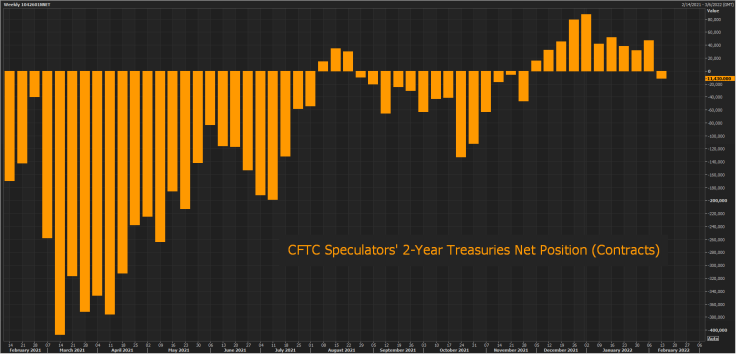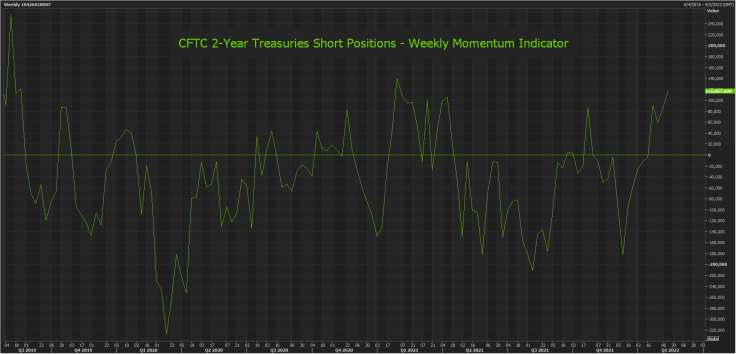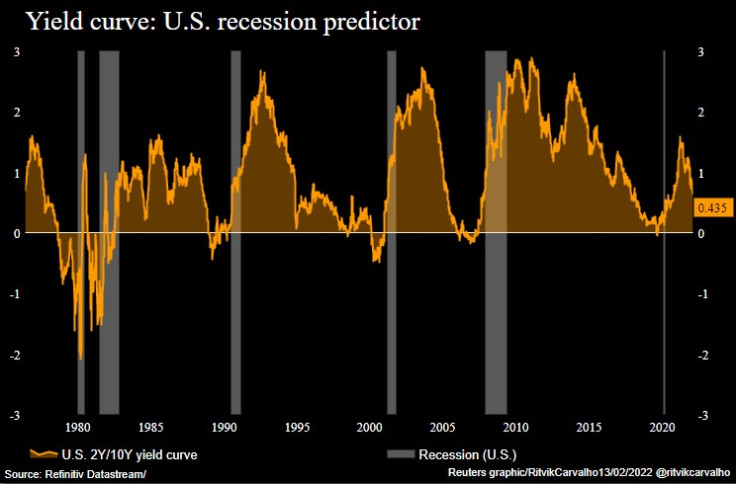Column-Funds On Right Side Of Historic U.S. Bond Market Move: McGeever

Hedge funds look to be on the right side of the seismic moves in Treasuries that have propelled short-dated borrowing costs higher, intensified flattening pressures across the yield curve, and ripped up the consensus 2022 U.S. interest rate outlook.
Futures market data for the week through Feb. 8 showed speculators flipped to a net short position in two-year Treasuries for the first time this year and cut their net short position in the 10-year space to its smallest since October.
A deeper dive into the latest Commodity Futures Trading Commission report reveals that the bearish momentum in two-year futures is accelerating fast, and offers signs that bullish sentiment in 10-year bonds is emerging.
Together, this shows funds are betting that the 2s/10s yield curve will continue to flatten.
CFTC 2-Year Treasuries -

The CFTC data are for the week through Tuesday Feb. 8, two days before figures showed inflation in January jumping to a 40-year high of 7.5%.
That triggered a 24-basis point rise in the two-year yield, the most for a single day since June 2009, and a 13 basis point narrowing of the spread between two- and 10-year yields, the fourth biggest compression in a decade.
Money markets are now pricing in at least 150 basis points of tightening from the Federal Reserve this year, starting with a 50 bp rate hike in March, and Wall Street banks have revised their Fed outlook sharply higher.
Hedge funds were net short 11,430 contracts of two-year Treasuries, the first net short this year. The week-on-week swing of around 59,000 contracts was the biggest bearish shift since October.
A short position is essentially a bet that an asset's price will fall, and a long position is a bet it will rise. In bonds, yields rise when prices fall, and move lower when prices rise.
The swing to a net short position was down to funds opening new shorts and closing out longs. Momentum indicators show that momentum on the short side is the strongest in a year.
CFTC 2-Year Treasuries Short Momentum -

The CFTC data also showed that funds cut their net short 10-year U.S. bond position by some 73,000 contracts to around 202,000, its smallest since October. The change was almost entirely due to fresh longs being opened, perhaps indicating that a more fundamental shift in outlook is underway.
Collectively, that's a bet on a higher two-year yield and lower 10-year yield. This trend has been in place for months but is accelerating rapidly. The curve is only 40 basis points from inversion, the red flag that has preceded all six recessions in the past 45 years.
If the Fed follows through on expectations for the most aggressive tightening cycle in a quarter of a century, recession in 2023 or 2024 is a clear and growing risk.
"It is widely accepted that the Fed had over-stimulated and has been significantly behind the curve over the last several months. However, it does not make sense to compound that mistake by swinging to the other extreme. Errors are additive; they do not cancel out," Citi rates strategists wrote on Friday.
US 2s/10s Yield Curve & Recessions -

On top of the economic reasons for buying 10-year bonds and betting on further flattening of the yield curve, there may also be technical arguments for doing so. Only two weeks ago, speculators' long positions in 10-year futures were barely 400,000 contracts, the lowest in almost five years. There is room to add, especially with a yield of 2% on offer.
And if Russia invades Ukraine, the most liquid and safest market on the planet might be expected to draw strong investor demand, regardless of the inflation or technical picture.
Macro strategies made money in January, bucking the wider downtrend across the hedge fund industry. Funds betting on higher short-term yields and flatter curves will be sitting pretty for another positive month in February.
(The opinions expressed here are those of the author, a columnist for Reuters.)
(By Jamie McGeever; Editing by Sam Holmes)
© Copyright Thomson Reuters 2024. All rights reserved.




















